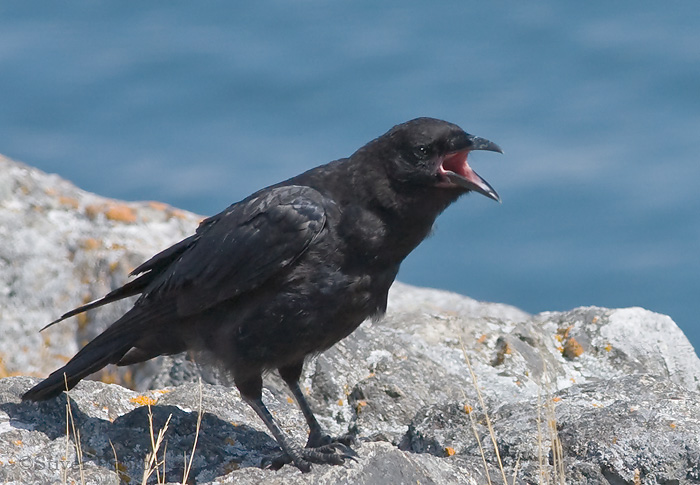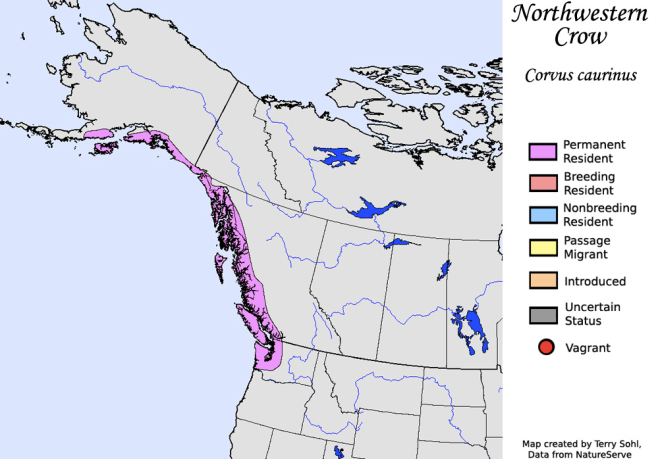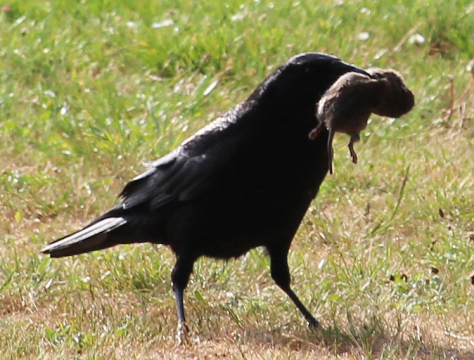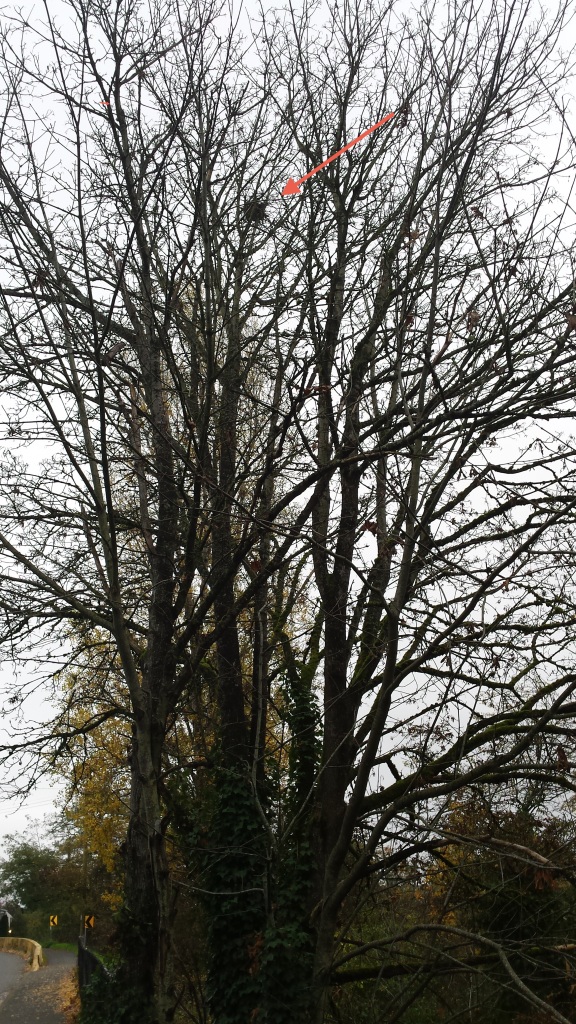A murder in the ‘hood!
You may not have heard about the events in my neighbourhood on Vancouver Island last night or on every autumn evening preceding it. I’m referring to the fall and winter pre-dusk flocking behaviour of crows, specifically Northwestern Crows (Corvus caurinus). Like all species of crows they are in the Corvidae family with jays, magpies and ravens and are easy to differentiate from most other birds because they are social and relatively large with shiny black plumage and familiar loud calls. Among the world’s most intelligent creatures Northwestern Crows and crows in general, have complex cognition comparable with chimpanzees (Emery and Clayton, 2014).
Ubiquitous within their range, the crows live in both rugged, remote habitats and highly urbanized environments (http://www.birdvancouver.com/b_northwestern_crow.html). During the evening, the crows of my neighbourhood fly from their daytime foraging spots on beaches, backyards and street corners to a few Douglas Fir trees on my street above the harbour. From these treetops they can, with their excellent vision, no doubt observe a spectacular and expansive portion of the species’ range extending along the Pacific coast from Puget Sound in northwestern Washington, north up the entire shoreline and coastal mountains of British Columbia all the way to Kodiak Island in western Alaska (Brewer, et al., 2006).
A keen eye, ear and sense of geography is needed to accurately differentiate the Northwestern Crow. It has a lower call, smaller size (380gm), slightly shorter body length (40cm), and purely coastal range in comparison with the similar, closely related American Crow (Corvus brachyrhynchos) (Sibley, 2003). Additionally, the species hybridize (Tweit, 2015) and both exhibit monomorphism meaning there is no difference in size or appearance between the sexes. Genetic testing is underway to help resolve whether they are actually separate species or whether the Northwestern is simply a subspecies of the American genus (Tweit, 2015). Many people also confuse coastal crows with the Common Raven, a larger corvid with a more robust bill, a wedge-shaped tail, shaggier feathers on the neck and legs and a deep ‘croaking’ call (Brewer, et al., 2006) (Link, 2005).
The Pacific coastal habitat provides rich feeding opportunities for the birds. Along the shore they forage on sandy beaches and rocky outcrops eating mussels and clams, or searching in tide pools for other marine invertebrates and picking at animal carcasses. They will prey on small mammals and in the summer their predatory instincts result in stealing seabird eggs and juveniles from nests (Cornell University, 2015). In fact, they have adapted so well to every type of coastal environment that their omnivorous diet leads to a combination of natural foods and, though usually indirectly, human supplied food that they supplement their diet with (Marzluff and Angell, 2008). A frequent visitor to dumpsters in my community, crows have learned that a brown bag dropped on the street likely contains a source of fast food (Marzluff and Angell, 2008).
I miss the crepuscular gatherings between April and August when the birds are active locating nesting territory, building or repairing nests, incubating eggs and feeding juveniles (http://www.ec.gc.ca/aobc-cabb/index.aspx?lang=En&nav=bird_oiseaux&aou=489). Northwestern Crows are monogamous and together pairs choose a discrete nesting location that they may perennially return to on rocky islets, high up in a crook of tree lining city streets, or in dense brush (Ehrlich et al., 1988).
Tree nests are made of long sticks with a soft grass and hair lined cup-shaped interior and ground nests are a smaller more loosely amalgamated version (Ehrlich et al., 1988). The male assists the female in nest building and then the female lays 4 or 5 bluish-green coloured eggs with brown speckles that incubate in 17-20 days (Cornell University, 2015). The birds are born altricial meaning they are helpless at birth unlike a precocial duckling which can swim and walk almost immediately after hatching (Cornell University, 2015). Juveniles remain in the nest 29-35 days (Cornell University, 2015) during which time the parents may be assisted by a young offspring from a previous season that guards the nest or helps supply food (Link, 2005). Through this cooperative behaviour adults pass on information to the next generation and there is the added benefit of reduced incidence of nestling mortality (Ehrlich et al.,1988). Crows that have left the nest and are finished feeding may leave or stay with the parents to assist in the following year’s breeding activity and then will annually gather again in fall and winter to roost over their decade long lifespan (Link, 2005).
As the seasons change to fall, high in the crown of my neighbourhood trees crows perch for a brief time to stage and announce their presence with a distinct loud: ‘kaah kaah’ (Gullison, 2015). As more crows locate them and their numbers increase they continue on their way to their nocturnal roosting territory. Roosting activity is considered a form of security and information exchange aiding in food and mate finding and is an important way for young individuals to learn from older ones (Link, 2005). My local twilight gatherings involve only a few dozen individuals and are modest in contrast to some flocks.
In BC, where the majority of the global population resides (Campbell et al., 1997) a decline in the species’ population has occurred over the past twenty years. However, due to a longer term increase they are considered secure in province (BC Conservation Data Centre, 2005). A successful synanthropic adaptation (living among humans), has led to a population increase in urban areas (Marzluff et al., 2001) and with that come challenges that frequently occur when any abundant population lives in close proximity with humans. There is the threat of West Nile Virus as corvids are highly susceptible, the fear of health risks associated with feces and feathers at large roost sites, the threat of attack during nest protection behaviour and those that simply perceive them as a pest (Link, 2005). Consequently, throughout the three larger jurisdictions they inhabit, Alaska, BC and Washington, Northwestern Crows can be hunted, with a few restrictions, and with a licence (Alaska Department of Fish and Wildlife, 2015) (BC Ministry of Environment, 2015) (Link, 2005).
I’m rather fond of crows and have no plans whatsoever to shoot them, however, I’m looking forward to the next murder…




